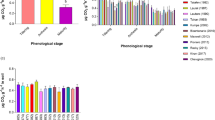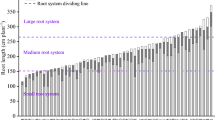Abstract
The effect of direct inoculation of seeds with the plant growth promoting rhizobacteria (PGPR) Azospirillum lipoferum CRT1 was assessed on maize (Zea mays) grown for 35 days after sowing (d.a.s.) in controlled conditions (greenhouse) in a luvisol soil from south-eastern France. WhinRhizo® software was used to describe the following changes in the root system morphology for each plant: distribution and average root diameter, root surface and the number of tips. The stress at breakage and stiffness of the roots in tension were also determined. Evaluation of biochemical components of roots was achieved by direct Attenuated Total Reflectance (or reflection) (ATR)-Fourier transform infrared (FTIR) on root section. Inoculated roots exhibited significantly larger numbers of tips and extending surface to rhizosphere when compared to controls. Measured mechanical parameters of inoculated roots showed a slight increase in rupture stress up to the largest diameter (1.2 mm) when compared to controls. Stiffness (Young’s modulus) values were nearly constant for inoculated plants with higher values than for non-inoculated plants at day 26 and day 35. Using Principal Components Analysis of ATR-FTIR profiles, the polysaccharide enrichment of inoculated roots compared to controls was found at day 35. Noticeable absorbance at wavenumber specific to aromatic ether (lignin) was observed in control plants. All these data had a pattern of immature root properties, when maize was inoculated with Azospirillum lipoferum CRT1. Observed modifications of root development are possibly conducive to unseen beneficial effects, like water retention, resistance to mechanical stress, or root litter quality. Studies on more mature plants are required to assess if the differences between inoculated and control plants would persist or become accentuated with time until harvest.




Similar content being viewed by others
References
Allison DG (2003) The biofilm matrix. Biofouling 19(2):139–150
Bashan Y, Holguin G (1997) Azospirillum–plant relationships: environmental and physiological advances. Can J Microbiol 43:103–121
Bashan Y, Holguin G, de-Bashan LE (2004) Azospirillum–plant relationships: physiological, molecular, agricultural, and environmental advances (1997–2003). Can J Microbiol 50:521–577
Carpita NC, McCann MC (2000) The cell wall. In: Buchanan BB, Gruissem W, Jones R (eds) Biochemistry and molecular biology of plants. American Society Plant Physiologists, Rockville, MD
Carpita NC, Defernez M, Findlay K, Wells B, Shoue DA, Catchpole G, Wilson R H, McCann MC (2001) Cell wall architecture of the elongating maize coleoptile. Plant Physiol 127(2):551–565
Czarnes S, Dexter AR, Bartoli F (2000) Wetting and drying cycles in the maize rhizosphere under controlled conditions. Mechanics of the root-adhering soil. Plant Soil 221:253–271
D’Angelo-Picard C, Faure D, Penot I, Dessaux Y (2005) Diversity of N-acyl homoserine lactone-producing and -degrading bacteria in soil and tobacco rhizosphere. Environ Microbiol 7(11):1796–1808
Dobbelaere S, Vanderleyden J, Okon Y (2003) Plant growth-promoting effects of diazotrophs in the rhizosphere. Crit Rev Plant Sci 22(2):107–149
Dokken KM, Davis LC, Marinkovic NS (2005) Use of infrared microspectroscopy in plant growth and development. Appl Spectrosc Rev 40(4):301–326
El Zemrany H, Cortet J, Lutz MP, Chabert A, Baudoin E, Haurat J, Maughan N, Felix D, Defago G, Bally R, Moenne-Loccoz Y (2006) Field survival of the phytostimulator Azospirillum lipoferum CRT1 and functional impact on maize crop, biodegradation of crop residues, and soil faunal indicators in a context of decreasing nitrogen fertilisation. Soil Biol Biochem 38(7):1712–1726
Ennos AR, Crook MJ, Grimshaw C (1993) The anchorage mechanics of maize, Zea mays. J Exp Bot 44:147–153
FAO (1974) http://www.fao.org/AG/agl/agll/key2soil.stm
Glansdorp FG, Thomas GL, Lee JK, Dutton JM, Salmond GPC, Welch M, Spring DR (2004) Synthesis and stability of small molecule probes for Pseudomonas aeruginosa quorum sensing modulation. Org Biomol Chem 2:3329–3336
Goodman AM, Ennos AR (1998) Responses of the root systems of sunflower and maize to unidirectional stem flexure. Ann Bot 82:347–357
Groleau-Renaud V, Plantureux S, Guckert A (1998) Influence of plant morphology on root exudation of maize subjected to mechanical impedance in hydroponic conditions. Plant Soil 201:231–239
Hamza O, Bengough AG, Bransby MF, Davies MCR, Hallett PD (2006) Biomechanics of plant roots: estimating localised deformation with Particle Image Velocimetry. Biosyst Eng 94:119–132
Hepworth DG, Vincent JFV (1998) The mechanical properties of xylem tissue from tobacco plants (Nicotiana tabacum ‘Samsun’). Ann Bot 81:751–759
Jacoud C, Wadoux P, Job D, Bally R (1999) Initiation of root growth stimulation by Azospirillum lipoferum CRT1 during maize seed germination. Can J Microbiol 45:339–342
Joseleau J-P, Ruel K (1997) Study of lignification by noninvasive techniques in growing maize internodes. Plant Physiol 114:1123–1133
Kim SW, Ban SH, Chung H, Cho S, Chung HJ, Choi PS, Yoo OJ, Liu JR (2004) Taxonomic discrimination of flowering plants by multivariate analysis of Fourier transform infrared spectroscopy data. Plant Cell Rep., Physiol Biochem 23:246–250
Kokubo A, Sakural N, Kuralshi S, Takeda K (1991) Culm brittleness of barley (Hordeum vulgare L.) mutants is caused by smaller number of cellulose molecules in cell wall. Plant Physiol 97:509–514
Kos G, Lohninger H, Krska R, Griffiths P (2004) A comparative study of mid-infrared diffuse reflection (DR) and attenuated total reflection (ATR) spectroscopy for the detection of fungal infection on RWA2-corn. Anal Bioanal Chem 378:159–166
Lin-Vien D, Colthup NB, Fateley WG, Grasselli JG (1991) The handbook of infrared and Raman characteristic frequencies of organic molecules. Academic Press, London, p 503
Li Y, Qian Q, Zhou Y, Yan M, Sun L, Zhang M, Fu Z, Wang Y, Han B, Pang X, Chen M, Lia J (2003) BRITTLE CULM1, which encodes a COBRA-Like Protein, affects the mechanical properties of rice plants. Plant Cell 15:2020–2031
Mccann MC, Chen L, Roberts K, Kemsley EK, Sene C, Carpita NC, Stacey NJ, Wilson RH (1997) Infrared microspectroscopy: sampling heterogeneity in plant cell wall composition and architecture in hormones, regulating and signalling substances in plant growth and development. Physiol Plant 100(3):729–738
Mccann MC, Bush M, Milioni D, Sado P, Stacey NJ, Catchpole G, Deferenez M, Carpita NC, Hofte H, Ulvskov P, Wilson RH, Roberts K (2001) Approaches to understanding the functional architecture of the plant cell wall. Phytochemistry 57: 811–821
Moore AK, Owen NI (2001) Infrared spectroscopic studies of solid wood. Appl Spectrosc Rev 36(1):65–86
Nelson LM, Knowles R (1978) Effect of oxygen and nitrate on nitrogen fixation and denitrification by Azospirillum brasilense grown in continuous culture. Can J Microbiol 24:1395–1403
Nguyen C (2003) Rhizodeposition of organic C by plants: mechanisms and controls. Agronomie 23:375–396
Piccoli P, Masciarelli O, Bottini R (1999) Gibberellin production by Azospirillum lipoferum cultured in chemically defined medium as affected by oxygen availability and water status. Symbiosis 27:135–145
Sarig S, Blum A, Okon Y (1988) Improvement of the water status and yield of field-grown grain sorghum (Sorghum bicolor) by inoculation with Azospirillum brasilense. J Agric Sci 110:271–277
Schopfer P, Lapierre C, Nolte T (2001) Light-controlled growth of the maize seedling mesocotyl: mechanical cell-wall changes in the elongation zone and related changes in lignification. Physiol Plant 111:83–92
Thuler DS, Floh EIS, Handro W, Barbosa HR (2003) Plant growth regulators and amino acids released by Azospirillum sp. in chemically defined media. Lett Appl Microbiol 37:174–178
Trinsoutrot I, Jocteur Monrozier L, Cellier J, Waton H, Alamercery S, Nicolardot B (2001) Assessment of the biochemical composition of oilseed rape (Brassica napus L.) 13C-labelled residues by global methods, FTIR and 13C NMR CP/MAS. Plant Soil 234:61–72
Vial L, Cuny C, Gluchoff-Fiasson K, Comte G, Oger PM, Faure D, Dessaux Y, Bally R, Wisniewski-Dye F (2006). N-acyl-homoserine lactone-mediated quorum-sensing in Azospirillum: an exception rather than a rule. FEMS Microbiol Ecol 58(2):155–168
Watt M, McCully ME, Canny MJ (1994) Formation and stabilization of rhizosheaths of Zea mays L. Effect of soil water content. Plant Physiol 106:179–186
Witkowski MR, Ciolino, LA, DeFrancesco JV (2006) GHB free acid: II. Isolation and spectroscopic characterization for forensic analysis. J Forensic Sci 51(2):330–339
Acknowledgements
The authors wish to thank Dr R. Pépin for helpful advise in plant processing, and Anne Bonhommé for technical assistance in ATR-FTIR spectra. This work is part of Hamdy El Zemrany’ Ph.D., with a financial support by the Research Ministry in Egypt. The Scottish Crop Research Institute receives grant-in-aid from the Scottish Executive Environment and Rural Affairs Department.
Author information
Authors and Affiliations
Corresponding author
Rights and permissions
About this article
Cite this article
El Zemrany, H., Czarnes, S., Hallett, P.D. et al. Early changes in root characteristics of maize (Zea mays) following seed inoculation with the PGPR Azospirillum lipoferum CRT1. Plant Soil 291, 109–118 (2007). https://doi.org/10.1007/s11104-006-9178-0
Received:
Accepted:
Published:
Issue Date:
DOI: https://doi.org/10.1007/s11104-006-9178-0




